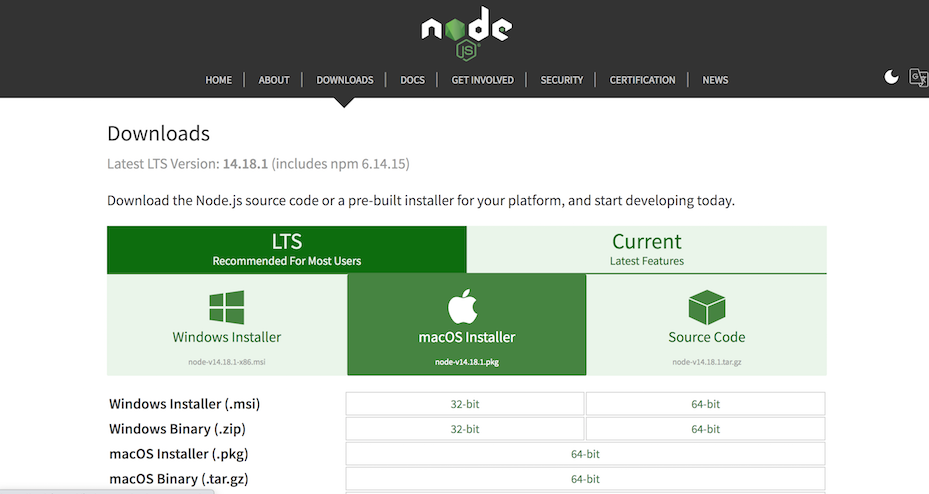

- #HOW TO TYPE CODE NODE JS MAC TERMINAL INSTALL#
- #HOW TO TYPE CODE NODE JS MAC TERMINAL UPDATE#
- #HOW TO TYPE CODE NODE JS MAC TERMINAL DOWNLOAD#
Its primary purpose is to build fast, scalable network applications easily. Node.js is a platform that is built on Google Chrome’s JavaScript runtime.
#HOW TO TYPE CODE NODE JS MAC TERMINAL UPDATE#
With each update you download, the older versions of both npm and Node will be replaced by the newer ones.
#HOW TO TYPE CODE NODE JS MAC TERMINAL DOWNLOAD#
Simply download the file and run it and the installation wizard will handle the rest. These packages make installation efficient and simple to understand. There are pre-made installers available to make the process easy. However, there’s no need to make your life difficult. The download page on Node.js includes binary packages for both MacOS and Windows. Updating Node on Windows/MacOS Using Installers So, for the next update, try the second method first. Then, use the following code for installing the binary package in usr/local: tar C /usr/local -strip-components 1 -xJf node-v6.9.2-linux.圆4.tar.xz
#HOW TO TYPE CODE NODE JS MAC TERMINAL INSTALL#
So, to install this, run the code sudo apt-get install xz-utlis. You will also need xz-utils for unpacking the file. Remember, the Node version will change as more updates are released. However, it is better to use the console. You can download the binary file from a browser. From here, get the 32-bit or the 64-bit Linux binary file. As a last resort, go to the official download page for Node.js. You can also get a specific Node version by running n #.#.#. Run the following code to clear the cache and install n along with the latest Node version: sudo npm cache clean -fįinally, use n latest to install the most recent release. You will also need npm’s n module to update Node. To ensure npm is updated correctly, run npm -v. Then install the recent npm update by entering npm install -g. Node already comes installed with npm however, the manager is updated more often than Node.Ĭheck the version you have with npm -v.

It also allows users to manage dependencies. NPM (node package manager) helps to discover, share as well as use code. The second best option after nvm is a package manager. Also, set up a default with an alias by nvm alias default node. You can also inform nvm the version you want to use in each shell with nvm use #.#.#. Remember, the # here will be replaced by the Node version you want. Now, download, compile, and then install the latest version of Node by typing nvm install #.#.#.

You can also see the version available to install with nvm by ls-remote. You can check the version of Node installed currently by typing nvm ls. Once everything is set up, installing the updated Node version is hardly any difficulty. If everything worked, then the command will output nvm. However, you can verify if the installation is successful by using the command -v nvm. If you want to install or update Node version manager, get the install script with cURL: curl -o- | bashįirst, close and open the terminal again. Sudo apt-get install build-essential checkinstall libssl-dev First, run an update to get the packages using these commands: sudo apt-get update For this, you need a C++ compiler, the build-essential and libssl-dev packages. NVM ( Node Version Manager), as mentioned earlier, is the best way to update Node. However, if you’re unable to go with the Node Version manager method, then you can update either via binary packages or package managers.

We recommend method one because of its simplicity. We’ve listed the three common and most effective ways to update node on the Linux operating system. You can do this by writing node -v in the command prompt.ģ Methods of Updating Node.js on Linux Machines We’ll be covering Linux, macOS, and Windows-based machines.īefore getting started, determine the Node.js version you have. In the following article, we’ve mentioned the easiest yet the most effective methods of installing the newest Node version. So, you’ll have no problems in getting the most recent Node.js version. There are numerous methods one can use to update Node to the latest version on different operating systems. The updates are not only limited to just one version branch they are spread among all of them. After almost every two weeks, there is some update or the other to boost both security and stability. Just like a majority of other open-source environment, Node.js has become quite a fast-evolving project.


 0 kommentar(er)
0 kommentar(er)
